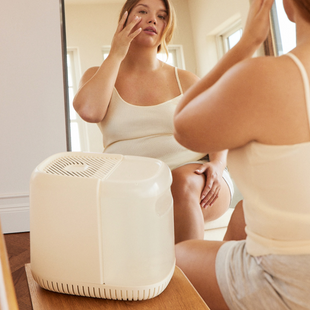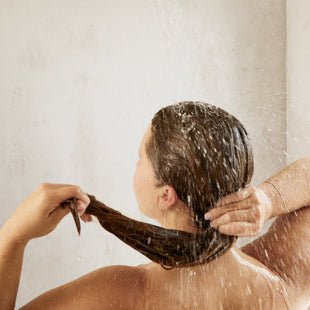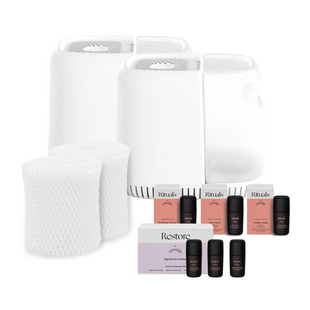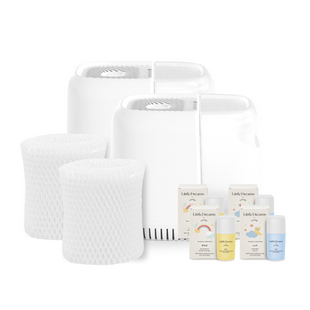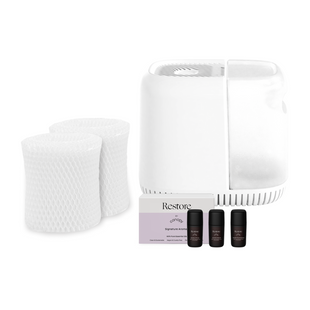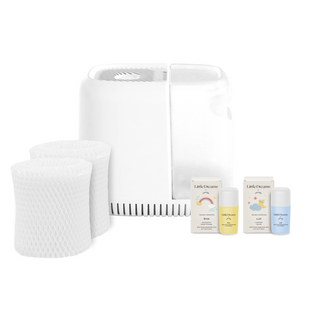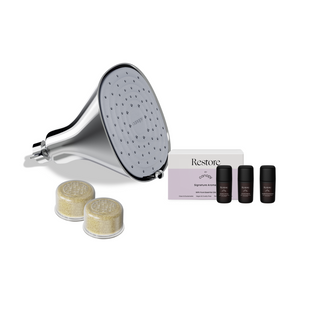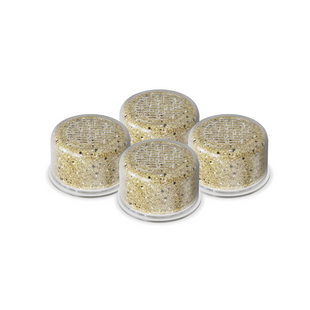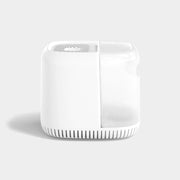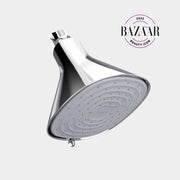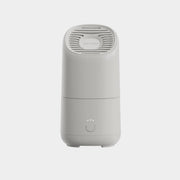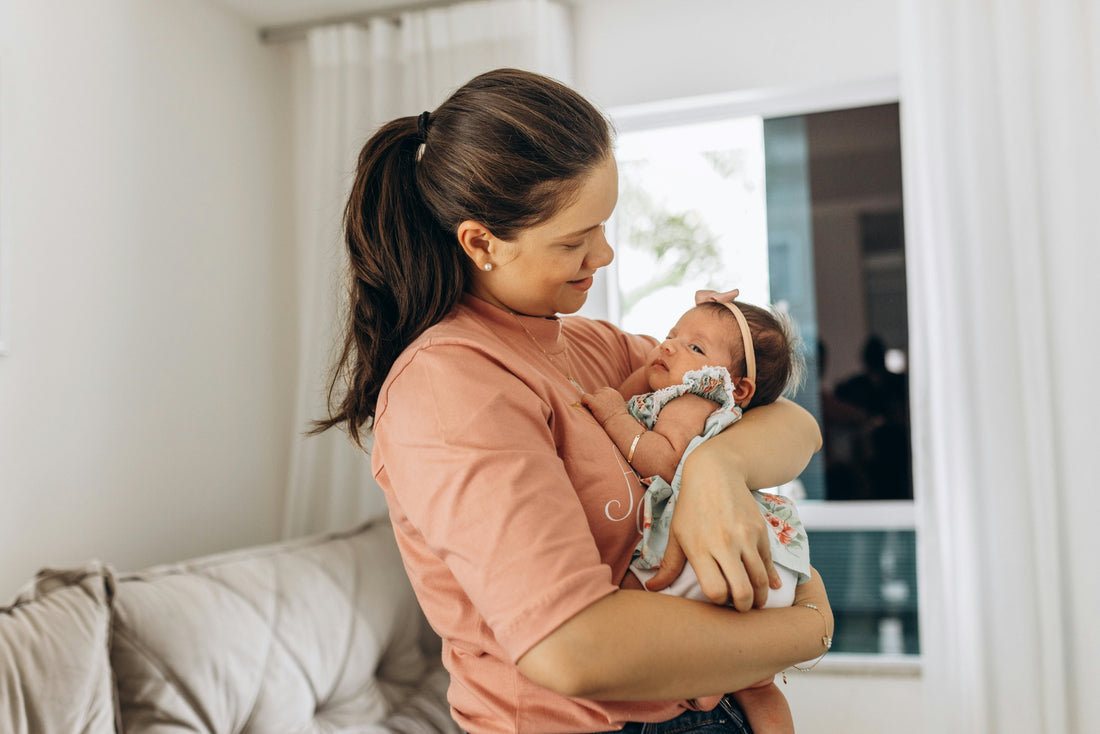Babies are incredibly fragile, especially during the first few months of life. As a parent, you set up baby monitors and safety gates, put locks on cabinet doors, baby-proof sharp corners, and take other steps to protect your bundle of joy from harm.
You might also find your newborn's every cough and sniffle concerning. But don't worry! It's not uncommon for pediatricians to receive frequent calls for guidance from concerned, sleep-deprived parents.
Is your newborn extra fussy at bedtime? Do they have unexplainably dry, irritated skin? Do they exhibit cold-like symptoms that worsen at different times of the year? After a doctor examines your infant and rules out all the possibilities that you hastily searched on your way to the doctor’s office, they might suggest changing the moisture levels inside your home. A dry environment affects infants in various ways and is likely to blame for your newborn's discomfort.
The Canopy Nursery Humidifier creates a comfortable, safe environment for babies to give parents peace of mind. Explore Canopy's Baby Care Guide for tips for new parents. Our guide details newborns' common skin and respiratory issues, explains how increasing the nursery humidity level can help, and makes a strong case for why you should choose a Canopy humidifier.
Why Canopy Cares About Skin Wellness
Canopy takes skin wellness seriously. The lack of water in skin compromises the barrier, leaving the body's largest organ dry, tight, and dehydrated. The accompanying dullness, rough texture, and itchiness add to the woes.
The Canopy humidifiers support healthier, hydrated skin. The collection also includes filtered showerheads that remove hard minerals, chlorine, and other substances that dry out skin.
Baby Skincare Concerns

If your baby's scalp is flakey, red, extra oily, or has scaly white-yellowish patches, your little one might have a “cradle cap.” The non-contagious, painless condition affects 70% of infants by the age of three months, but it usually goes away as the baby gets older.
Cradle cap is linked to hormones and Malassezia, a yeast strain found in sebum (the body's natural oil). Run a humidifier when your infant has a cradle cap as part of their baby skincare routine. When skin is too dry, sebum production increases. The Canopy Nursery Humidifier hydrates up to 500 square feet. Your baby's skin absorbs the water vapor to combat dryness and dehydration.
Babies' skin is prone to dryness during winter. The cold winter air holds less moisture than warm air. Cold air absorbs moisture from numerous sources, including your baby's skin. The central heat inside further dries out the air, causing your youngster's skin to dry out. Turn on the humidifier to prevent flakey skin, chapped lips, rough texture, and other symptoms associated with winter dryness.
Because a baby's skin is thin and porous, chemicals in fragrant baby products could cause irritation. Opt for products with organic ingredients instead, as they’re gentler than other ingredients, like synthetic added fragrances.
Baby Respiratory Health
When your baby inhales pollen, their immune system responds accordingly. Cells release histamine to battle the foreign substance. In the process, histamine might inflame their airways, causing wheezing. A dry cough is also an allergy symptom your baby might experience.
Tree pollen counts are high from February to May, while grass pollen is problematic from April to June. Weed pollen causes allergy issues between August and November. Use a humidifier during these times to alleviate your little one's allergy symptoms. The moist air reduces inflammation in the airways and helps break up congestion. When pollen counts are high, close windows to keep the allergen out of your home.
Colds and allergies both share many symptoms and can affect newborn breathing. Unlike allergies, a cold can include a fever. It's easy for infants to catch colds because their immune system hasn't fully developed. Run a humidifier to thin the mucus that contributes to coughing. The added moisture keeps airborne viruses at bay, too.
Humidifiers & Baby Safety

Canopy creates cool mist humidifiers as a way to address infant safety concerns. A filter absorbs the water, and a fan evaporates it as invisible, room-temperature moisture. The filter traps contaminants to clean the air your baby breathes.
The Smart Persistent Airflow™ (SPA) technology further inhibits mold growth to improve indoor air quality. Sensors can tell when the device is out of water, so damp conditions won’t cause mold growth. Detach the humidifier’s tank, cap, and tray and pop them in the dishwasher to keep the device clean. Don’t place the body of the humidifier in the dishwasher, as this component holds all electrical aspects of the appliance.
At Canopy, we’re dedicated to your baby's safety. We do not recommend diffusing essential oils around babies under 3 months old, as their bodies are still adapting to their surroundings. Make sure to thoroughly read our manual before using the unit, as we provide tips to help new parents adjust to a humidifier routine.
How Canopy Helps Parents Adjust
Becoming a parent is arguably one of the biggest changes you can encounter in a lifetime. While nothing can prepare you entirely for the many aspects of parenthood, we’re dedicated to providing tips to help new parents adapt.
What to Look For in a Humidifier
While these benefits are compelling, it’s important to be choosy about the humidifier you place in your baby’s room. Not all humidifiers are created equal, so here are a few important qualities to look for in a nursery humidifier:
- Anti-mold technology: Since infant safety is paramount when choosing any items that will go in your nursery, many parents turn to cool mist humidifiers as an alternative to warm vapor models, which could pose burn risks. But a better alternative is a no-mist humidifier like our Nursery Humidifier. It uses proprietary Smart Persistent Airflow™ technology, a mold-inhibiting design that prevents mold and bacteria from entering the device. UV lights inside the tank work to eliminate 99.9% of bacteria, and a disposable paper filter traps any remaining contaminants.
- Automatic shut-off: When the body is sleep-deprived, it’s easy to forget simple tasks, like turning off the light in the kitchen at the end of the night. That’s why having an automatic shut-off feature can be convenient. Your baby’s humidifier will turn off when the room hits ideal humidity levels or the tank runs out of water, so you don’t have to worry about turning the device off manually.
- Easy to clean: Canopy’s Nursery Humidifier features easy-to-clean components. Simply pop the tank, cap, and tray in the dishwasher and run them on a regular cycle. Make sure to keep the body of the humidifier dry and away from moisture to avoid the electrical components from becoming damaged. Replace the filter at six-week intervals, and take advantage of our automatic filter delivers to cross yet another task off your to-do list.
Setting Up the Nursery
Getting your baby’s nursery ready can be an exciting way to prepare for their homecoming. Not only does it satisfy your nesting instinct, but it also ensures your baby’s space is ready for day-to-day activities. From diaper changes to bedtime and everything in between, having an organized and baby-friendly environment will make your life as a new parent easier to navigate.
While there are dozens of nursery must-have lists with all sorts of items on them, the reality is that babies need very little to thrive. Aside from food and clothing, a safe sleep space is one of the only true essentials. But there are several other items that can make newborn days more comfortable for everyone.
One game-changer is a humidifier. Introducing a humidifier to your baby’s nursery offers a number of important benefits, including:
- Improved skin hydration to reduce eczema and cradle cap, common baby skincare challenges
- A well-hydrated nasal passage to prevent or alleviate congestion
- A soothing environment for better sleep
- Reduced risk of illness, including bacterial and viral infections
While the recommended humidity levels for your home are between 40% and 60%, many indoor environments are much drier. This can lead to a number of uncomfortable side effects, including nasal congestion and dry skin—conditions that could inevitably lead to a fussy baby.
Tips for Humidifier Placement
To ensure your baby stays safe near the humidifier, we recommend the following tips for placement:
- Place the humidifier 3 to 4 feet away from your baby's crib and at least a foot away from the walls. This distance prevents the moist air from soaking walls, bedding, toys, and furniture, causing mold growth.
- To hydrate the entire room, place the humidifier in a central location that doesn't restrict airflow.
- Keep the unit secure in place to prevent it from tipping over or being knocked over by an excited pet or a curious, crawling baby.
- Make sure the device’s wires are well out of your baby’s reach and tucked away to avoid tripping hazards.
Establishing a Sleep Routine

Sleep deprivation is almost a guarantee during the newborn days. Babies wake frequently when they’re very young, and from nighttime feeds to diaper changes and general fussiness, it’s completely normal for your baby to have frequent wakes throughout the night. Developing a consistent sleep schedule is something that will come in time. Don’t feel panicked if you’re not clocking as many hours of sleep in those early days—your baby will eventually establish a routine and regulate their sleep cycle.
First and foremost, you’ll want to assess your baby’s sleep arrangements to make sure they’re in line with safe sleep practices, such as removing extra blankets from their crib, which could pose a choking hazard, or swaddling them to keep them cozy. Aside from these basics, you can also create a soothing sleep space for them. Turn off all the lights in the nursery and set the temperature between 68 and 72 degrees Fahrenheit.
Babies often respond well to white noise since it mimics the sounds your baby heard in the womb. It can also help to filter out normal household sounds during nap time and the early evening. While there are many white noise machines available for babies, you can cross this item off your list if you already plan to place the Canopy Nursery Humidifier in their room.
In addition to delivering soothing, moist air to their sleep environment, the device’s gentle operating sounds create comforting background sounds for your little one to drift off to. And you can rest assured that the volume is well within the recommended limits of 50 decibels or lower, which is considered safe for babies’ ears. The steady hum will be just quiet enough to lull your baby softly to sleep.
Essential oils can also benefit your baby at bedtime. Every order of the Nursery Humidifier + Filter Subscription includes fragrance blends from the Little Dreams Aroma Kit. Like adults, certain scents can evoke different moods in babies, too. For example, diffusing essential oils—like lavender, chamomile, eucalyptus, and vanilla—can support relaxation and encourage sleep. Browse the Little Dreams Aroma Kit and our other soothing scents, which can be used with our nursery humidifier for the most effective experience.
Handling Baby’s First Upper Respiratory Symptoms
It can be upsetting the first time your baby shows signs of a cold or congestion, but it’s a common issue most new parents will encounter. Babies’ nasal passages and airways are much smaller than ours, so even minor congestion can make newborn breathing difficult. And as little ones begin to explore the world, they’re also susceptible to germs that cause colds and other viruses. Coming down with the common cold is a normal part of growing, but that doesn’t make symptoms any easier for babies or their parents.
Since babies aren’t quite ready to handle the cold medicines that adults and older kids rely on to banish symptoms, new parents have to use other methods to control symptoms and give their babies relief. An infant’s system isn’t equipped to handle medication the same way an older child’s can. Fortunately, there are several home remedies you can use to help your baby feel better:
- Clear nasal passages: Keeping your baby’s nasal passages clear and well hydrated are two of the most important goals for supporting newborn breathing in a congested baby. Many parents use bulb syringes to extract nasal mucus, which can free their passageways to support better airflow. There are also handheld nasal aspirators which can suction out snot for unobstructed nasal passages. Saline sprays may also be useful, but be sure to use a non-medicated formula and consult your pediatrician if you’re unsure.
- Introduce moist air: Inhaling moist air is another way to help improve your baby’s respiratory system. The American Academy of Pediatrics recommends humidifiers for thinning mucus in babies. The device provides a continuous supply of moist air to alleviate symptoms like cough and congestion in infants. Canopy’s Nursery Humidifier will come in handy here: it can run for up to 36 hours, providing an uninterrupted stream of hydrated air to keep your baby comfortable around the clock.
Canopy’s Nursery Humidifier is a three-in-one solution for your baby’s room: it hydrates the air to eliminate dryness and the problems that come with it, it acts as a calming sound machine, and it diffuses essential oils for relaxing scents. Plus, with the ability to help address respiratory symptoms, it can help keep your baby comfortable by supporting clear airways for healthy newborn breathing.
Solutions From Canopy
Canopy’s dedication to baby health is at the forefront when it comes to safety features in our humidifiers. We are passionate about helping all parents provide the best care for their babies through our products, all of which are designed with comfort and safety in mind.

